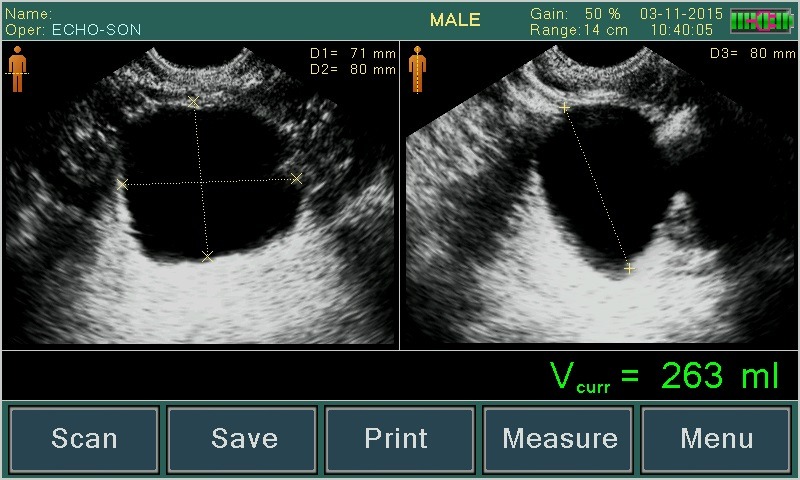

The Bladder Ultrasound Scanner: Vsono-BL1 is used to non-invasively visualize, monitor, and measure the urine volume in the bladder, with a measuring range of 10ml to 2000ml. Post void residual volumes - < 20 mL (under 6 years) or < 10mL (6 years and over) is considered normal Normal bladder wall thickness < 1 cm (> 1cm is abnormal and requires referral to rule out neurogenic bladder) Normal rectal diameter < 3cm (if > 3 cm highly suggestive of constipation) Mid-stream urine rule out Urinary tract infection.
Vendra Medical team suggests ultrasonography, instead, specifically using the Wireless Bladder Ultrasound Scanner: Vsono-BL1 Therefore, an invasive measuring method, such as catheterization, is not encouraged. PVR varies in a given individual, hence multiple measurements are often necessary. A dysfunction in 1 part can result in PVR. The bladder, the external sphincter, and the detrusor activities must be synchronized for a healthy voiding. PVR is a way to help detect urinary tract disorders if there are any. This encourages as well the formation of urinary stones, which can be directly harmful to the entire urinary system. Since the rinsing of the bladder is impaired, germs can easily settle on the inner wall of the bladder and cause infections. Review efficacy and side effects of alpha blockers/ anticholinergics/ mirabegron 6 weeks after initiation.If the bladder cannot be completely emptied, so-called residual urine remains. oxybutynin/vesicare/toviaz) increase as tolerated. It is therefore worth trying at least 3 different preparations if response is limited or side effects are not tolerated.įor products with variable dose (e.g. Response and side effect profiles vary between individuals. Third line: Mirabegron (Betmiga) 50mg (25mg if eGFR<30)Ĭonsider Mirabegron earlier if cognitive side effect of anticholinergics are of concern
#POST VOID BLADDER VOLUME NORMAL PATCH#
Trospium (Regurin XL) 60mg oxybutynin patch (Kentera) twice weekly Second line (once daily): Solifenacin (Vesicare) 5/10mg Fesoteridine (Toviaz 4/8mg frequency, urgency, nocturia) continue to cause bother.įirst line: Oxybutinin 5mg (2.5mg elderly?) bd-tds, immediate release tolterodine 2mg bd oxybutynin, tolterodine, fesoterodine, trospium xl, solifenacin etc) Consider in addition to above if storage symptoms (ie. Residual volume 30cc, “plum” on rectal examination, or PSA > 1.4) Post void residual bladder scan (where available, NB need voided volume> 150mls for validity)

To diagnose nocturnal polyuria (1/3 total 24hr urine output passes at night)Ĭheck renal function if suspected chronic urinary retention (LUTS with palpable bladder/raised post void residual) recurrent UTs history of renal stones To assess type and quantity of fluids prior to conservative treatments Frequency volume chart (drinking/voiding diary for 3days).This can be variable with residual volumes of 300 mL to >3 L being measured. Straightforward LUTS can be reasonably managed in primary care. If available in primary care, a simple post-void bladder scan can quantify the residual bladder volume.

Renal impairment secondary to bladder outlet obstruction ie hydronephrosisīenign prostatic obstruction, most likely diagnosis age 55 - 80 Normally, a minimal amount or no urine should be left in the bladder after urination. Voiding: Hesitancy, poor flow, terminal dribblingįailed medical/conservative treatment and patient bothered by symptoms. What is Post-Void Residual Urine Volume Postvoid residual volume is a measurement of the amount of urine left in the bladder after urination. Storage: Frequency, nocturia, urgency, incontinence Lower urinary tract symptoms may be classed as: Information for GDPs / Dental Practices.Management of acute urinary retention in men.Scrotal Mass Suspicious for Testicular Cancer & Benign Masses.Chronic Fatigue Syndrome/Myalgic Encephalomyelitis.


 0 kommentar(er)
0 kommentar(er)
